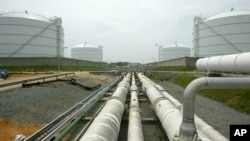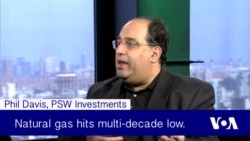Natural gas prices reached the lowest levels since 1998 on March 1, with spot Henry Hub prices falling to $1.57. The Henry Hub is a gas distribution facility which is widely quoted for U.S. prices because it connects nine interstate and four intrastate pipelines.
Crude oil prices are dominating media coverage, but history is being made in the natural gas sector. For some context, natural gas markets are regional, so not every country experiences low prices in the way that oil-producing countries do. While natural gas may be trading in the $1 range in the U.S., Europe sees an average of $4.90 and Japan trades at about $9.
VOA looked at data from the U.S. Energy Information Administration website. Just like crude oil, natural gas production is historically high, which means storage levels are elevated since there is not enough demand to take some of the product out of the system. Natural gas suffered the same fate as the retail sector this past winter due to abnormally warm weather in the U.S. as a result of El Nino phenomenon.
The U.S. natural gas market is seasonal, with storage buildups between spring and fall, and drawdowns in the winter. Back to the correlation with retailers, because of the warm weather, many of them got stuck with excess inventory and had to write down product not sold, which adversely affected gross margins. That resulted in quarterly and annual earnings losses.
The same principle applies to supply and demand in the natural gas and crude oil markets. Demand for natural gas dropped to a 31-year low in recent months, while storage remained at all-time highs.
Despite the negative data, Phil Davis of PSW Investments is buying stock in the physical commodity of natural gas and the United States Natural Gas ETF, ticker symbol UNG. This type of investment is an exchange-traded security that is designed to track in percentage terms the movements of natural gas prices.
"Natural gas is regionally priced to the local market. Now, with the advent of liquefied natural gas (LNG) exporting, you now have a set global price. LNG will be exported around the world and supply will draw down," said Davis.
The U.S. Energy Department has approved projects that may send abroad as much as 283 million cubic meters per day of U.S. gas, and it is considering applications for another an additional amount.
With LNG exports currently starting up, the U.S. could emerge as a global gas superpower on par with the current leaders, Russia and Qatar. Global demand for natural gas is expected to be 50 percent higher by 2035 than it currently is.






